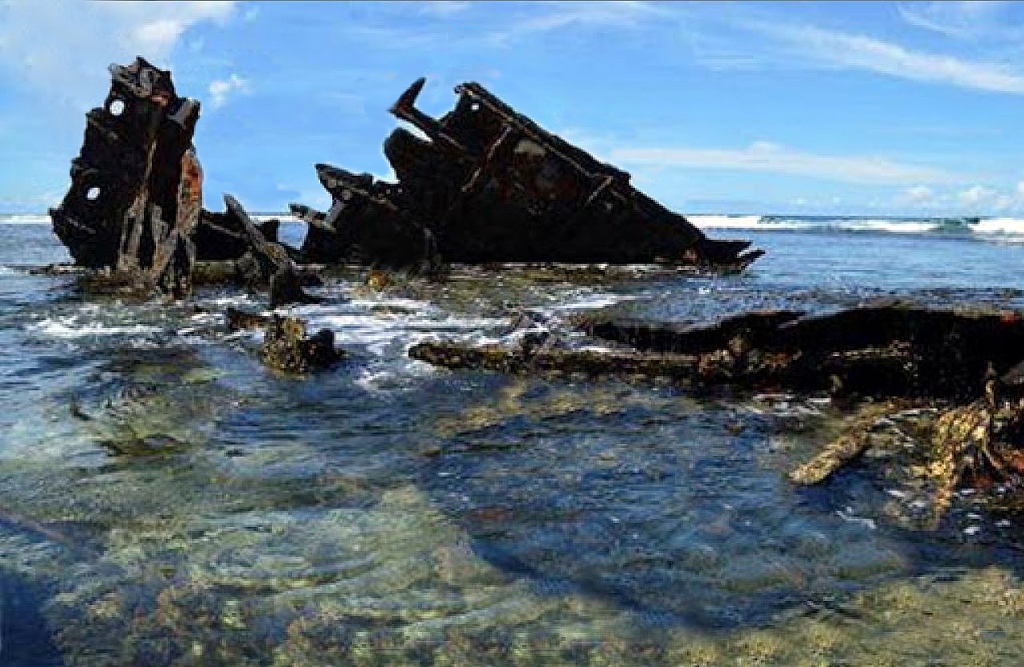THE compilation of this historical event from various accounts shows that, like in case of sinking of Titanic in 1912, this tragedy which had happened 28 years before, was also due to human negligence. We never seem to learn.
They died about a century ago but their spirits reportedly roam near their death spot.
And whenever they are seen, they say something which the iTaukei population of the area is not too familiar with.
Sometimes, their cries can also be heard from their “deathbed” — the sunken ship Syria — part of which is lying on Nasilai Reef off Nasilai Village in Nakelo, Tailevu.
It is the story of indentured labourers who were brought to Fiji from India when the ship met her fate on the night of May 11, 1884, claiming 59 lives.
The Syria was a 1010 tonne iron sailing ship (not steamship). It was named after the Syria River in Karnataka in India.
About its ill-fated trip, the Syria left Calcutta in India on March 13, 1884 with 497 passengers in search of a better life in Fiji, like their fellow countrymen who first arrived here on May 14, 1879.
Records reveal that the ship had a crew of 43, of which 33 were lascars, sailors.
On sighting Kadavu at 9am on May 11, 1884, the captain failed to allow for the strong winds and currents and consequently, the ship was closer to Nasilai Reef than the captain believed.
By 7pm, there was a full moon and had a lookout been posted on the masthead, disaster could have been averted as the breakers would have been visible from a long distance.
At 8:15pm, the ship was about half a mile from the reef when the breakers were sighted and despite the captain’s desperate measures to turn her, the Syria ran aground at 8:30pm. Some crew members went to look for assistance in the lifeboat that survived.
It states that the four crew members reached Nasilai Village at dawn but their inability to communicate with the natives resulted in them being taken to Levuka instead of Suva.
“On reaching Levuka at 5pm, a rescue party was organised and they reached the stricken ship at 9pm,” the online encyclopaedia states.
“Dr William MacGregor, the chief medical officer and acting colonial secretary, took charge of the rescue operations on the morning of Tuesday May 13.”
It is reported that when the first rescue boats reached the scene, the majority of the passengers were in the water on the reef, making it as far towards the land as they could.
But a considerable number was still in the wrecked vessel, mainly women and children, as the ship lay on her port side with everything thrown about in the breakers.
The survivors were carried by boats and canoes to Nasilai Village, with the last rescue boat reaching the village at 8pm.
Later enquiries showed that somebody was sleeping on the job. The inexperienced crew, some reportedly drunk, allowed the ship to drift off course, and consequently, at 8:30 pm, the vessel went aground, and the rest is history.
As Ram Prasad from Nakelo and Peniasi from Nasilai Village, sat around their usual grog bowl at Nausori market on a Saturday morning, their talk centered around the legend of the Syria tragedy, and newspaper reports of ghosts. Peniasi confirmed the tales of the villagers that after over a century ago, their souls still seem to haunt the place.
They feel their spirits still roam near where the ship sank.
At times, they say, their cries can also be heard from their “deathbed” in Hindi, the spot of Syria sinking, where a part of it is still lying on Nasilai Reef off Nasilai Village in Nakelo, Tailevu.
There, are various version of the rescue efforts and tales of gallantry. But one thing is certain — the milk of human kindness so much in abundance in the Taukei culture, won the day.
Unfortunately, Fijian history hasn’t resonated with such acts of iTaukei compassion and sacrifice.
This has been a remarkable feat and human gesture that has been ignored by the white-men’s version of Fiji History.
We have witnessed that both the Fijians and Indians stand by each other in times of need and disaster. Indeed, there is enormous reservoir of love, affection and goodwill between the two races that needs to be revealed, promoted and cherished.
It is a pity; the White men’s history has a bias which failed to highlight such positive stories which were often lost in accounts that gave much credit and praise to the colonial masters while others were only mentioned in passing.
The focus on the Syria misfortune should not so much dwell in the tragedy of that event, but more importantly to highlight the face of hope and compassion that surfaced from it.
Let us salute those gallant villagers once more, on the 142nd anniversary of tale of compassion, love and the milk of human kindness that history seems to have forgotten. We pray for them all.
History being the subject it is, a group’s version of events may not be the same as that held by another group. When publishing one account, it is not our intention to cause division or to disrespect other oral traditions. Those with a different version can contact us so we can publish your account of history too — Editor.
• THAKUR RANJIT SINGH is a Founding Trustee of Aucklandbased Fiji Girmit Foundation NZ, which made a thanksgiving pilgrimage to Nasilai Village in October, 2015. He is a journalist, a media commentator and a blogger, based in Auckland. The views expressed are his and not necessarily shared by this newspaper



